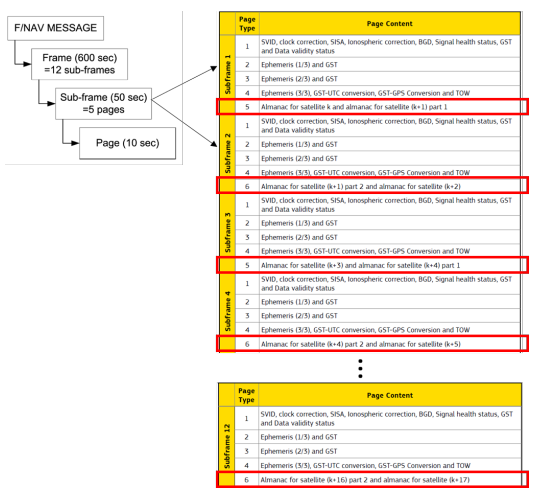The Galileo almanac is a set of Keplerian parameters that allows to reconstruct satellite position coordinates only approximately, whilst having quite long period of validity compared to the so-called ephemeris coefficients. A coarse information about where the Galileo satellites are is necessary for the receiver or smartphone to know which satellites are potentially visible and therefore, it allows to reduce the time of their signal acquisition and subsequent tracking process. The almanacs are broadcast within the navigation message, and they can be also downloaded from the GNSS Service Center web site.
“I only had to wait for 10 minutes to get position with my brand-new Galileo receiver”. Keep calm and…get the almanac.
What happens when a receiver is turned on for the first time? On powering, the receiver checks for the availability and ageing of its almanacs; if they are outdated or missing, the device starts searching for the availability of any Galileo signals. After acquiring and tracking the first signal obtained from a Galileo satellite, the receiver decodes its navigation message which contains, (among other parameters): the ephemeris parameters (allowing to precisely estimate own position of the satellite broadcasting such signal) and the almanac parameters (allowing a coarse determination of its own position, but containing information for all the remaining satellites of Galileo constellation). Since the size of a navigation message requires more bits than the ones than can be transmitted within the signal per second, at least 10 minutes are needed to have a complete message available and therefore, having a full almanac.
By knowing roughly its position and the one of the satellites in view, the receiver can focus on attempting the acquisition and tracking for those space vehicles instead of doing this exercise for the whole constellation, and therefore, shortening the time to achieve the minimum required number of ranging observables for a successful determination of its coordinates. In summary: having the almanac information in advance will help to identify the satellites most likely to be in sight, reducing the duration of the overall signal acquisition, tracking and position determination process.

Galileo navigation message is detailed in the Galileo SiS Open Service Interface Control Document.
The almanac is saved within the receiver, being ready for use. If the satellites have moved hundreds kilometres or it has been a long time since its last acquisition, then the almanac is discarded. Whenever almanacs are available, the receiver will need less time to get a first position fix.
What is inside the almanac? The Galileo almanac contains information about where and how the satellites are. For each of the Galileo satellites, it provides information about the position in the orbit and the health of the satellite. Detailed information about the almanac parameters is provided in the Galileo SiS Open Service Interface Control Document. As a summary, the almanac parameters consist of:
• Semi-major axis
• Eccentricity
• Inclination
• Longitude of the ascending node
• Argument of perigee
• Mean anomaly
Besides the broadcast navigation message, a complementary almanac to facilitate the Galileo signal acquisition is provided by the GNSS Service Centre (GSC). The Galileo almanac (in .xml format) is uploaded twice a week (Tuesday and Friday) and it can be downloaded under the menu GSC products.
Having almanacs available helps to reduce convergence time to get a reliable position and power consumption of devices. For example, most of new smartphones use Assisted GNSS which can significantly improve the smartphone performance. The technique is based on providing information or computational resources to the smartphone in order to facilitate the location process. The provision of the almanac is one of the approaches to achieve time and power optimization.
The updated Galileo almanac is available easily and free to all interested users. Always remember that if you need an older almanac, you can request to GSC the almanac of interest through the “Request on demand products” form available on the GSC web portal.
Go and get you first Galileo almanac!
Media note: This feature can be republished without charge provided the European Union Agency for the Space Programme (EUSPA) is acknowledged as the source at the top or the bottom of the story. You must request permission before you use any of the photographs on the site. If you republish, we would be grateful if you could link back to the EUSPA website (http://www.euspa.europa.eu).